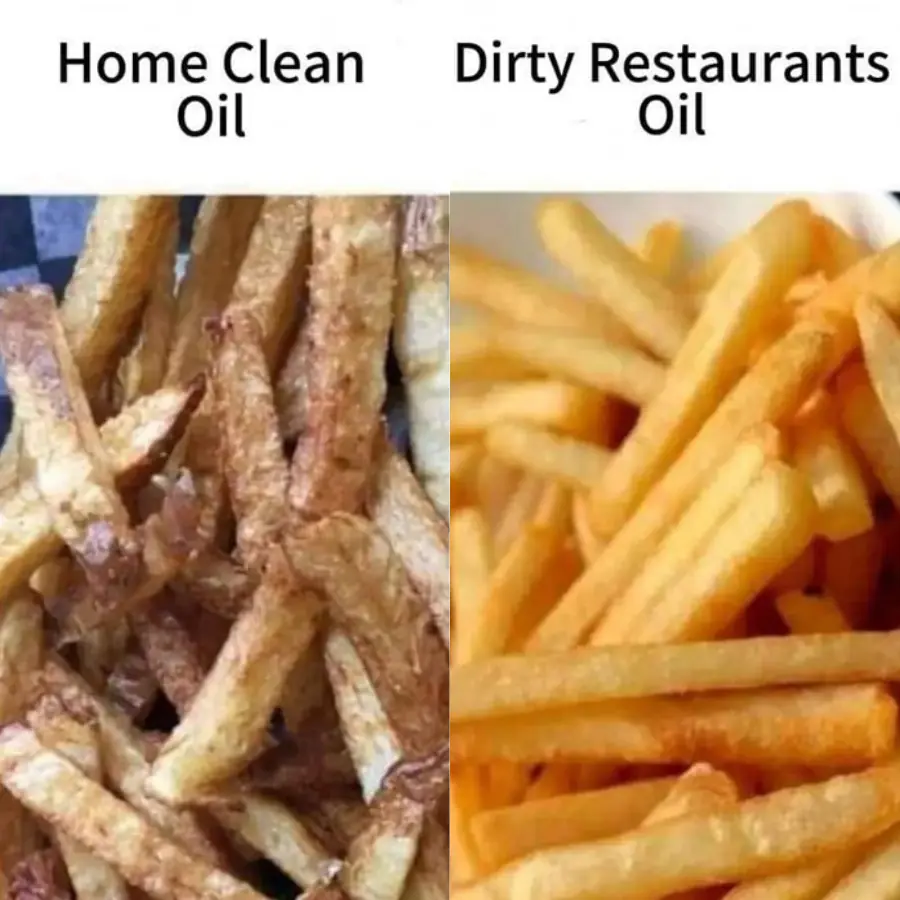Let’s be honest: few things are more frustrating than craving crispy, golden fries and ending up with a plate of soggy, sad potato sticks at home. You followed the recipe, used fresh oil, and even waited for the right temperature. So why do restaurant fries always seem crispier, more golden, and let’s face it—more addicting?
Spoiler alert: it’s not just about the potatoes. It’s a carefully engineered process that most home kitchens simply don’t follow. But that doesn’t mean homemade fries aren’t amazing in their own rustic way.

The Science Behind the Golden Crunch
At a glance, the difference between homemade and restaurant fries might look like a case of dirty oil vs. clean oil—but the truth goes deeper.
Restaurants don’t just chop up potatoes and toss them into hot oil. Their fries go through multiple stages: washing, soaking, blanching, freezing, and then frying—sometimes twice. This process builds that signature crisp crust while keeping the inside soft and fluffy.
Meanwhile, at home? We skip half those steps, use fresh oil, and often fry once. That creates a softer, more potato-forward fry that’s golden in its own earthy, homemade way.
Why Restaurant Fries Hit Different
There’s a reason fries from fast food joints and restaurants come out picture-perfect. Let’s break down the key steps they follow:
- Soaking: Restaurants soak sliced potatoes to remove excess starch, which prevents clumping and helps achieve that smooth finish.
- Blanching: Fries are partially cooked at a lower temperature first to soften the inside.
- Freezing: After blanching, they’re often flash-frozen to lock in moisture and ensure consistency.
- Double Frying: The final fry at a higher temperature gives them that golden, crispy exterior.
- Oil Management: Ironically, that “dirty” oil in restaurants actually helps with color and flavor due to residual fry bits and heat stability.
Video : sometimes the meams are like this!!!
It’s less about the oil being clean or dirty and more about it being properly seasoned, reused (to a degree), and kept at an ideal temperature.
What Home Cooks Get Wrong (And How to Fix It)
The difference in texture and taste isn’t because you’re doing it wrong—it’s just that home fries are usually more natural. But if you want to level them up, here’s where many go off track:
- Skipping the soak: Starch makes fries soggy. Soak them in cold water for at least 30 minutes and dry them thoroughly before frying.
- Not drying the potatoes: Water and hot oil don’t mix. Pat those fries dry unless you enjoy an oil splatter show.
- Frying at one temp: A low, slow first fry and a high-temp second fry is the magic formula.
- Using brand-new oil: Sounds crazy, but super clean oil lacks depth. Let your oil build a little character over a few batches—just not burnt or overly dark.
Home Fries: Real, Rustic, and Full of Heart
Here’s the thing—homemade fries may not win a beauty contest, but they’ve got something no frozen fry can replicate: authenticity. That slightly uneven color? It means you used real potatoes. The extra chew? That’s homemade charm.
Besides, isn’t there something satisfying about tossing hot, golden fries with your own spice mix or dipping them in homemade sauce?
The Oil Myth: Why “Dirty” Doesn’t Mean Dangerous
Let’s bust a myth while we’re at it: dirty oil isn’t always bad. Restaurants reuse oil strategically. After multiple uses, the oil develops what chefs call “fry seasoning,” which enhances the taste and color. As long as it’s filtered and not overheated or rancid, it actually helps.
Video : 15 Mistakes Beginners Make Cooking Food For the Week
In contrast, clean oil in home kitchens delivers a more neutral fry. While it might not brown as evenly, it’s free from potential allergens or flavor carryovers. You’re trading off crispness for purity—neither is better, just different.
Can You Make Restaurant-Style Fries at Home?
Absolutely! But it takes patience and planning. Here’s your home-kitchen blueprint:
- Cut fries evenly for consistent cooking.
- Soak them in cold water to reduce starch.
- Dry completely before frying.
- Blanch at 300°F (150°C) until limp but not colored.
- Let them rest or freeze for 30+ minutes.
- Fry again at 375°F (190°C) until crispy and golden.
- Salt immediately after frying.
Bonus: A light dusting of cornstarch pre-fry can help crisp up homemade fries even more.
Conclusion: Your Fries, Your Rules
Sure, restaurant fries look more polished. But your homemade fries? They’re real. They’re yours. And they taste like comfort.
Next time someone compares your fries to a fast food joint, just smile. You’re not cooking for mass production—you’re cooking for flavor, freshness, and maybe even a little nostalgia.
Golden perfection doesn’t have to come from a fryer designed for 500 batches a day. Sometimes, it comes from the heart, your kitchen, and the joy of crisping things your own way.


